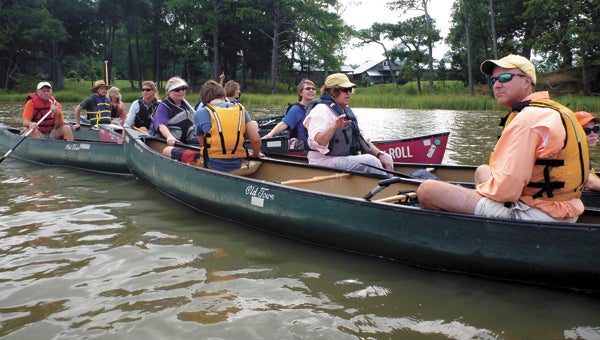Paddling along the Chuckatuck
Published 11:32 pm Wednesday, September 26, 2012

City Councilman Robert Barclay, right, watches nature as Karla Smith of the Nansemond River Preservation Alliance explains how citizens can help keep the river healthy.
Although only five and a half miles or so separate its headwaters near Godwin Boulevard from its mouth at Batten Bay, where it empties into the James River, Chuckatuck Creek flows much longer through the history and life of Suffolk.
Following about 13 miles of twists and turns along the route, a group of explorers along the creek is led through areas representing Suffolk from all its important eras.
With their canoe paddles and quiet voices the only sounds to be heard this summer morning, the voyagers are looking for signs of man’s influence on the creek and of the difference it has made, in turn, on the lives of families, farmers and watermen who have depended on it in one way or another through the centuries.
Karla Smith loves to tell folks about this creek that runs behind her house off of Cherry Point Road near Crittenden, and she relishes the opportunity to travel with a group of visitors along the winding waterway to describe the history of this Chesapeake Bay tributary.
There are places where trails as old as the area’s native Nansemond Indian tribe end at the water’s edge. There are the skeletal remains of old wharves that were vitally important to the economy as recently as World War II. And there are places where Union and Confederate troops could have watched one other from opposite sides of the water if not for the inherent danger of such a folly.
There are ramshackle lean-to buildings abandoned long ago and mansions whose modern glass façades afford expansive views of the tidal creek and its marshes. Docks and boatlifts along the route feature everything from jet-skis to luxury cabin cruisers, from johnboats to Chesapeake Bay deadrises.
Portions of Chuckatuck Creek have been important during the Civil War, during the Revolutionary War and during skirmishes between the English settlers and the Native Americans they encountered here, says Smith, who is co-chair of the Nansemond River Preservation Alliance’s education committee and chair of the Crittenden-Eclipse-Hobson Heritage Foundation.
Artifacts more than 3,000 years old have been found along the creek’s banks, she tells the visitors, and its recent history has been chronicled in part in the book “The River Binds Us,” a history of the communities near the mouth of the creek that was published in 2007 by the CEH Heritage Foundation.
Just as the Nansemond River helped define what would become downtown Suffolk and the interior portions of Nansemond County, Chuckatuck Creek influenced the communities along the northern end of the border between Suffolk and Isle of Wight.
Sandy Bottom, Hobson, Holley Point and Sawmill Point in Suffolk. Piney Point, Muddy Cove, Horseshoe Point and Cherry Grove just across the water — sometimes less than a stone’s-throw away — in Isle of Wight.
Before the construction of Crittenden Road, which runs roughly parallel to the waterway, Chuckatuck Creek marked the most accessible route for travelers and commerce to reach the then-bustling town of Chuckatuck and from there the interior of what was then Nansemond County.
There was a steamboat, the “Teddy,” that made the trek between Norfolk and Chuckatuck each day, and the creek was busy with commercial traffic at the beginning of the 20th century, with oystermen and ferrymen competing for space in its narrow channel, Smith says. “Truck farmers” used the wharves to unload produce from the farms of Isle of Wight and Nansemond County and bound for Suffolk and points east.
During the early and middle portion of the 20th century, a Portsmouth company, Lone Star Concrete, created lakes as much as 30 to 90 feet deep with its marl mining operations at the head of the creek. The materials were transported by train to Portsmouth from the mines just west of Chuckatuck. Deeded to Suffolk in the 1970s, Lone Star Lakes is now a favorite destination of fishermen and other outdoor enthusiasts. At high tide, one of those lakes, Crane Lake, would be accessible from the creek but for the signs that warn against crossing a breach formed during Hurricane Isabel.
There are no more steamships to ply the waters of Chuckatuck Creek, and it’s no longer economically important, except, perhaps, to a couple of watermen who moor their boats there. Today, the creek plays a greater role as a recreational destination and as home to a vast array of fish and wildlife.
Bald eagles patrol the skies far above the group of travelers, and kingfishers and egrets watch the marshes along the shoreline. An occasional fish breaks the surface of the water, and jellyfish can be seen floating in with the tide. Cicadas buzz from the deciduous trees that take over along the creek as the party moves upstream.
And beneath all this — below and behind and around the canoes silently floating with the incoming tide — one can almost feel the movement of Suffolk through time on this little Chuckatuck Creek.






